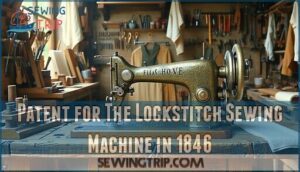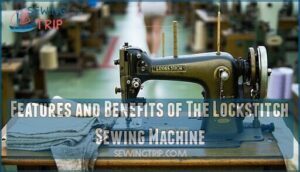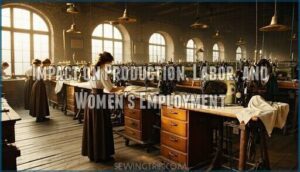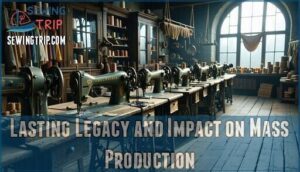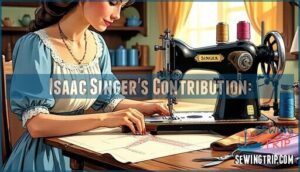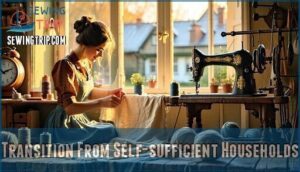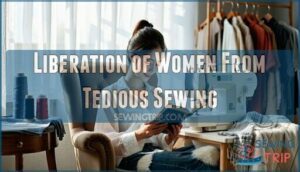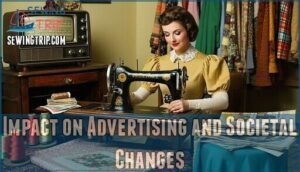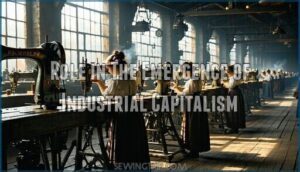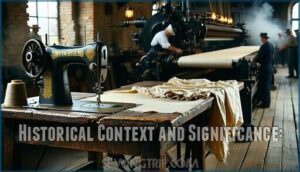This site is supported by our readers. We may earn a commission, at no cost to you, if you purchase through links.
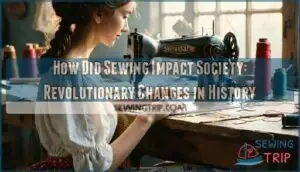
The sewing machine transformed everything from women’s daily lives to global economics.
Before mechanical sewing, making clothes consumed countless hours of hand-stitching – imagine spending weeks creating a single dress!
The invention liberated women from tedious needlework, enabling them to enter the workforce and pursue education.
It sparked mass production, making affordable clothing accessible to everyone, not just the wealthy.
This revolution created entire industries, changed how families functioned, and even influenced fashion trends by making complex designs achievable.
The ripple effects touched advertising, labor movements, and capitalism itself.
The sewing machine’s impact was profound, demonstrating how a single invention can have far-reaching consequences, making it a true revolution in societal and economic terms.
Table Of Contents
Key Takeaways
- You’ll witness mass production revolutionizing everything – The sewing machine transformed clothing manufacturing from expensive, time-consuming handwork to affordable mass production, making quality garments accessible to working-class families instead of just the wealthy elite.
- You’ll see women’s roles completely transformed – Sewing machines freed women from tedious daily needlework, enabling them to enter the workforce, pursue education, and gain economic independence while challenging traditional gender roles in society.
- You’ll find entire industries were born – The invention sparked the ready-to-wear fashion industry, created millions of manufacturing jobs, and established the foundation for modern industrial capitalism through mechanized production methods.
- You’ll discover households fundamentally changed – Families shifted from self-sufficient production units to specialized consumers, as the sewing machine eliminated the need for lengthy home garment-making and introduced labor-saving technology into daily life.
The Sewing Machine’s Early Development:
You’ll find that the sewing machine didn’t emerge overnight but evolved through decades of trial and error by determined inventors.
The journey from Thomas Saint’s 1790 design drawings to Barthelemy Thimonnier’s working machine in 1830 shows how persistence and innovation gradually transformed a simple concept into the tool that would reshape society.
Thomas Saint’s Design in 1790
Imagine this scenario: you’re witnessing the birth of a revolution that would reshape how the world makes clothes.
Thomas Saint’s blueprint in 1790 marked sewing history’s first real breakthrough, though his early prototypes couldn’t fully function with available technology.
His design evolution laid essential groundwork for sewing innovations that would transform the textile industry.
While machine mechanics weren’t advanced enough to bring Saint’s vision to life, his pioneering work sparked the industrial revolution’s garment production transformation.
This sewing technology foundation inspired future inventors to revolutionize how we create clothing.
William Newton Wilson’s Prototype
While Saint’s design remained theoretical, Wilson’s prototype development transformed those ideas into reality.
Working in textile mills during the 1790s, Wilson built the first functional model based on Saint’s plans.
His hands-on experience with textile industry operations informed key sewing innovations that improved the original design.
Wilson’s prototype development marked a pivotal moment in sewing history, demonstrating how theoretical concepts could become practical industrial impact tools that would eventually revolutionize the sewing machine landscape, making a significant impact on the industry with practical industrial tools.
Barthelemy Thimonnier’s French Sewing Machine
Barthelemy Thimonnier revolutionized French innovations in sewing mechanics when he patented the world’s first functional sewing machine in 1830.
His chain-stitch device could produce 200 stitches per minute, transforming textile technology.
However, fearful tailors destroyed his workshop during the 1848 Revolution, viewing mechanization as job theft.
Despite this machine destruction, Thimonnier’s legacy endured, inspiring future inventors and demonstrating industrialization’s inevitable march forward through persistent innovation.
The development of sewing machines relied heavily on understanding sewing machine history to improve their design and functionality.
Elias Howe and The Sewing Machine Revolution:
While earlier inventors struggled with clunky prototypes, Elias Howe’s determination transformed the sewing machine from a fascinating failure into a practical revolution that would reshape entire industries.
His 1846 patent didn’t just solve technical problems—it opened a new era where mass production would forever change how you dress, work, and live.
Elias Howe’s Motivation and Work Experience
Born into poverty, Elias Howe didn’t let humble beginnings define his destiny.
**Poverty sparked brilliance, turning struggle into mechanical revolution.
You’d find him working grueling 80-hour weeks as a machinist’s apprentice, but his mind constantly churned with mechanical possibilities.
This Industrial Pioneer possessed that rare spark—seeing solutions where others saw only problems.
When a conversation about profitable inventions sparked his interest in 1838, Howe channeled his frustration with tedious hand-sewing into innovation.
His Inventor Profile reveals someone who transformed personal struggle into societal revolution.
Through relentless experimentation with Lockstitch Design concepts, this sewing machine history icon laid groundwork for Patent Wars that would reshape the labor force forever.
The development of sewing machines relied heavily on understanding the sewing machine history to improve their design and functionality.
Patent for The Lockstitch Sewing Machine in 1846
After years of experimentation, Howe achieved his breakthrough in 1846 when he secured his lockstitch patent. This wasn’t just paperwork – it sparked Patent Wars that’d reshape American industry.
His Lockstitch Design featured three revolutionary elements:
- Eye-pointed needle threading from the tip
- Shuttle mechanism creating interlocked stitches
- Automatic feed system moving fabric consistently
This sewing machine patent launched the sewing machine evolution, proving Machine Efficiency could transform manufacturing forever. The invention of the sewing machine relied heavily on understanding early sewing machine history and its impact on the industry.
Features and Benefits of The Lockstitch Sewing Machine
Howe’s lockstitch mechanics revolutionized sewing innovation through its eye-pointed needle and shuttle system.
You’d notice dramatically improved sewing speed compared to hand-stitching, creating consistent stitch quality that wouldn’t unravel.
The machine durability meant fewer breakdowns during production, while superior thread management prevented constant tangles.
This sewing machine technology transformed manufacturing efficiency completely.
Impact on Production, Labor, and Women’s Employment
Elias Howe’s lockstitch sewing machine sparked a production revolution that you can’t ignore. By 1860, New Haven witnessed remarkable changes: 400 women using sewing machines produced 10,000 shirts weekly, while 2,000 hand-sewers previously made only 9,600.
This leap created both Economic Opportunities and challenges for women’s employment. The transformation brought mixed results for labor practices:
- Sweatshop Conditions emerged as factories prioritized speed over Workplace Safety
- Labor Movements formed when seamstresses earned $2-4 weekly but paid $150 for machines
- Gender Equality advanced as women entered garment making industries previously dominated by men
- Industrial progress increased workloads despite labor-saving promises
Women found themselves caught between liberation and exploitation in this new manufacturing landscape. The textile industry underwent significant changes with the introduction of additive manufacturing techniques.
Patent Challenges and Eventual Success
Defending his revolutionary lockstitch design wasn’t easy for Howe. The Patent Wars erupted when Isaac Singer and other manufacturers copied his innovations without permission.
These Legal Battles dragged on for years, draining Howe’s finances while competitors profited from his Sewing Innovations. But Howe fought back hard.
He hired skilled lawyers and pursued patent disputes relentlessly. The courts eventually recognized his patent rights, forcing infringers to pay substantial royalties.
This victory sparked Industrial Growth across America’s textile industry. Singer and others learned they couldn’t simply steal patented technology.
Howe’s triumph over sewing machine patents established important legal precedents, protecting future inventors while enabling legitimate Mass Production of these game-changing machines.
Lasting Legacy and Impact on Mass Production
Through mass production capabilities, the sewing machine transformed entire industries and sparked unprecedented economic growth worldwide.
**The sewing machine didn’t just change how we dress—it rewrote the blueprint for modern industrial civilization.
This technological innovation didn’t just change how clothes were made—it revolutionized manufacturing itself, creating the blueprint for modern industrial processes.
The sewing machine’s industrial revolution impact fundamentally reshaped society:
- Economic Boom: Production costs plummeted while output soared, making quality goods affordable for everyone
- Global Impact: Manufacturing spread across continents, creating millions of jobs and new trade networks
- Democratization of Fashion: Working-class families could finally afford stylish clothing previously reserved for the wealthy
- Technological Advancements: Mass production methods pioneered by sewing manufacturers influenced countless other industries
This single invention’s legacy extends far beyond textiles, establishing the foundation for today’s consumer-driven economy.
Isaac Singer’s Contribution:
While Elias Howe invented the lockstitch mechanism, you’ll discover that Isaac Singer transformed the sewing machine from a clever invention into a household revolution.
Singer’s genius wasn’t just in improving the machine’s design—he created the marketing strategies and business practices that brought this technology into millions of homes across America, which was a household revolution.
Marketing Strategies and Annual Production Figures
Through savvy advertising tactics and innovative sales approaches, Singer transformed sewing from a luxury into a household necessity.
His door-to-door campaigns and installment payment plans revolutionized consumer purchasing patterns, making mass production accessible to working families.
| Year | Production Units | Market Share | Revenue Growth |
|---|---|---|---|
| 1856 | 2,564 machines | 15% | Initial launch |
| 1867 | 43,000 machines | 45% | 1,577% increase |
| 1876 | 180,000 machines | 65% | Market dominance |
| 1890s | 500,000+ machines | 70% | Global expansion |
| 1900s | 1,000,000+ machines | 75% | Peak production |
Singer’s marketing strategies included aggressive newspaper advertising, branded promotional materials, and international showrooms. These tactics drove clothing production costs down while fueling the ready-to-wear fashion industry boom, leading to mass production and global expansion.
Impact During The Civil War
During the Civil War, you’d witness how sewing machines became absolutely essential for wartime production.
The Union army desperately needed massive quantities of uniforms and military garments – something impossible through hand-sewing alone.
Singer’s machines revolutionized domestic industry by enabling rapid uniform production, transforming civilian clothing manufacturers into essential war suppliers.
This wartime demand dramatically increased sewing labor wages and established the sewing machine’s critical role in America’s industrial capacity.
The development of sewing machines relied heavily on early innovations in sewing machine history, which played a significant part in America’s industrial capacity.
Use in Various Industries
Singer’s machines didn’t just revolutionize homes—they transformed entire industries. You’ll find these mechanical marvels became the backbone of textile production and garment manufacturing, birthing industrial capitalism as we recognize it today.
Here’s how different industries embraced this game-changing technology:
- Shoe Manufacturing – Production costs plummeted from 75 cents per pair to just 3 cents by the 1880s, with 125 million pairs produced annually by 1895
- Automotive Upholstery – Car manufacturers relied on precise stitching for interior components and convertible tops
- Fashion Industry – Mass production enabled ready-to-wear clothing, making stylish garments accessible to working-class families
- Leather Crafting – From saddles to military gear, leather goods became standardized and affordable through machine stitching
The development of industrial sewing machines relied heavily on advanced industrial sewing techniques.
This industrial boom created millions of jobs while making quality products accessible to everyone, not just the wealthy elite.
Societal Impact of The Sewing Machine:
You’ve witnessed how the sewing machine transformed individual households, but its ripple effects reshaped entire societies in ways that still influence us today.
From liberating women’s time to sparking the rise of industrial capitalism, this mechanical marvel didn’t just change how we make clothes—it rewrote the social contract of the modern world.
Transition From Self-sufficient Households
Before 1850, your household was like a mini-factory where you’d spend countless hours creating every piece of clothing by hand.
The sewing machine sparked a Household Change that revolutionized Family Dynamics forever. This Domestic Shift freed you from exhausting domestic labor and opened doors to Economic Freedom.
Here’s how this transformation unfolded:
- Production speed increased – You could now make garments 80% faster than hand-sewing
- Ready-made clothing emerged – By 1870, 60% of households bought factory-made clothes instead
- Specialized trades developed – Professional seamstresses replaced home economics production
- Urban migration accelerated – Families moved to cities for textile factory jobs
- Consumer culture began – laborsaving devices shifted households from production to consumption
This Social Evolution marked the end of total self-reliance, transforming the household economy from diverse production to specialized consumption.
Liberation of Women From Tedious Sewing
The sewing machine transformed women’s daily reality by freeing them from countless hours spent hand-stitching clothing.
Before this mechanical marvel, women dedicated enormous chunks of their day to tedious needlework that left little room for personal growth or outside pursuits.
| Before Sewing Machines | After Sewing Machines | Impact on Women |
|---|---|---|
| 14+ hours daily sewing | 2-3 hours daily sewing | 11+ hours freed up |
| Hand-stitched garments | Machine-made clothing | Faster production |
| Limited social interaction | Community involvement | Social Change |
| Household-bound activities | Educational opportunities | Women Empowerment |
| Economic dependence | Income-generating potential | Economic Independence |
This liberation sparked unprecedented womens empowerment as they channeled newfound time into education, social reform, and paid work.
The sewing machine impact on domestic labor created pathways to Economic Independence previously impossible.
Women’s voices grew louder in society as their Domestic Freedom expanded, contributing substantially to Gender Equality movements that reshaped America’s social fabric.
Impact on Advertising and Societal Changes
Consumer Culture exploded as manufacturers cleverly marketed sewing machines to transform daily life.
You’d see advertisements promising liberation from tedious handwork while promoting Modern Fashion Trends through mass-produced patterns.
These campaigns didn’t just sell machines—they reshaped Social Norms by positioning women as savvy consumers who could create stylish clothing affordably.
Mass Media reinforced Cultural Values linking domestic efficiency with feminine virtue, sparking a societal transformation that redefined how families viewed home production and personal style, highlighting the importance of domestic efficiency.
Role in The Emergence of Industrial Capitalism
Through the lens of mass production, you’ll witness how sewing machines became the backbone of industrial capitalism.
These technological marvels transformed traditional manufacturing processes, creating labor dynamics that shifted entire economic systems during the Industrial Revolution.
- Mass Production Revolution: Factories could now produce clothing in unprecedented quantities, dropping costs from 75 cents to 3 cents per shoe pair
- Economic Transformation: Ready-made clothing sector exploded from $40 million to $70 million between 1850-1870
- Labor Displacement: Traditional seamstresses moved from homes to centralized factories, creating new capitalist wage structures
- Industrial Growth: Mechanization accelerated the shift from "putting out" systems to consolidated production facilities
- Capitalist Systems: Clear separation between work and home established modern wage labor markets in urban areas
The growth of the industrial sewing machines market is driven by the increasing demand for global market trends in the apparel and non-apparel sectors.
Historical Context and Significance:
You’ll find the sewing machine emerged during the 19th century’s incredible wave of industrial innovation, alongside the steam engine, telegraph, and railroad.
This revolutionary invention sparked fierce patent battles between inventors like Howe, Singer, and Wheeler, ultimately creating the foundation for modern mass production that continues shaping our world today.
Broader Context of 19th-century Inventions
The 19th century buzzed with innovation like a factory floor at full steam.
You witnessed an era where brilliant minds raced to reshape everyday life through groundbreaking inventions.
The Industrial Revolution created fertile ground for technological advancements, with inventors competing fiercely to solve pressing problems.
Impact on Industrialization: The sewing machine accelerated industrial transformation by automating labor-intensive textile work, spurring Mass Production capabilities that revolutionized garment manufacturing nationwide.
Technological Advancements: Engineering breakthroughs in sewing machines mirrored the century’s relentless innovation spirit.
Hand-cranked models evolved into motorized versions, showcasing humanity’s drive for efficiency improvements.
Patent Disputes: Fierce legal battles between sewing machine inventors highlighted the era’s competitive landscape, where controlling revolutionary technology meant securing economic dominance and market control.
Economic Transformation: This invention redefined work structures completely.
Women gained factory employment opportunities while households saved precious time previously spent on tedious hand-sewing tasks, fundamentally altering economic relationships and Social Change patterns across communities.
The sewing machine stood among steam engines, telegraphs, and railroads as a catalyst for Economic Growth and societal evolution.
Early Attempts at Sewing Machines by Various Inventors
You’ll find the early 1800s brimming with ambitious inventors trying to crack the sewing code.
These pioneers faced technical nightmares that’d make modern engineers cringe:
- Saint’s Design required precise leather work but lacked proper documentation
- Wilson’s Prototype proved concepts worked but needed major tweaks for reliability
- Thimonnier’s Machine achieved 200 stitches per minute before angry tailors destroyed it
Hunt’s Abandonment and Wheeler’s Improvements showed how social resistance shaped innovation.
These sewing machine inventors created the foundation for Singer sewing machines and established a lasting sewing machine legacy through their 19th-century inventions and sewing innovations.
Connections to Intellectual Property and Lawsuits
Patent Wars erupted when inventors like Elias Howe fought Isaac Singer over lockstitch technology rights. You’ll find these Intellectual Rights battles shaped the entire industry’s future.
Howe’s 1846 patent became the center of major Copyright Issues, forcing competitors into costly Patent Litigation that lasted years. The Lawsuit Outcomes weren’t just about money – they established pivotal precedents for protecting Historical Inventions.
Singer eventually paid Howe substantial royalties, proving that Technological Advancements required proper legal recognition. This Litigation History shows how intellectual property laws evolved alongside innovation.
These legal battles ultimately strengthened patent protections, ensuring inventors could profit from their breakthroughs while spurring continued development in mechanized production.
Continued Relevance in Modern Times
Today’s fashion landscape shows how sewing technology continues reshaping society.
Modern Sewing machines integrate digital patterns and computerized features, making textile innovation accessible to everyone.
You’ll find sewing communities thriving online, sharing techniques and celebrating fashion innovation through social media platforms.
Digital patterns revolutionize how you approach garment creation, while technological advancements enable precise cutting and stitching.
This cultural evolution supports sustainable fashion movements, where you can repair clothes instead of discarding them.
The socioeconomic impact remains significant – home-based businesses flourish through online marketplaces, providing income opportunities.
Fashion trends now emerge from individual creators rather than just major brands, demonstrating sewing empowerment’s continued relevance in modern consumer culture.
This shift highlights the importance of technological advancements and digital patterns in the fashion industry.
Fun Facts:
You’ll discover some fascinating ways the sewing machine reached far beyond fashion and into unexpected corners of history.
From powering the Wright brothers’ first flight to becoming a treasured family heirloom, these machines created connections that still resonate in households today.
Use by The Wright Brothers
You’ll discover that Orville and Wilbur Wright used their sewing machine skills to craft aviation textiles for their historic flights.
Their background in bicycle repair and sewing innovations helped them select proper fabric and create flight suits.
The Wright Brothers applied sewing machine precision to aviation history, demonstrating how technological progress connects across industries through innovation.
Affordability and Impact on Personalization
Beyond just building airplanes, Singer’s revolutionary approach made sewing machines accessible to everyday people through installment plans.
When machines cost $125 but families earned only $500 annually, Singer’s $5-down payment scheme opened doors to Mass Production possibilities at home.
This Affordable Fashion revolution meant you could create Personalized Clothing without breaking the bank.
The democratization transformed how people expressed themselves.
Instead of wearing identical store-bought garments, you gained Economic Empowerment through custom fits and unique designs.
Fashion Accessibility became reality as Sewing Accessibility spread across social classes.
Your creativity flourished with decorative stitching, embroidery, and customized pieces that reflected personal taste rather than mass-market trends.
This Clothing Affordability sparked Fashion Democratization, letting ordinary folks craft extraordinary wardrobes.
The rise of sewing also led to increased interest in Affordable Clothing options for consumers.
Enduring Personal Connection in Households
Imagine your grandmother’s sewing machine sitting in the corner, collecting dust yet radiating memories.
Modern households maintain deep sentimental attachments to these machines, transforming them from mere tools into family heirlooms that bridge generations through shared sewing skills.
Home sewing continues thriving through:
- Family Ties – Passing down techniques and cherished machines across generations
- Household Chores – Mending clothes and creating Home Decor items economically
- Personalized Gifts – Crafting unique presents that strengthen Emotional Bonding
- DIY Culture – Joining online communities that celebrate creativity and self-sufficiency
This household economics approach saves money while fostering meaningful connections between family members.
Understanding the risks of sewing addiction issues can help individuals maintain a healthy balance between their sewing habits and daily life.
Frequently Asked Questions (FAQs)
How have sewing machines impacted society?
American clothing production skyrocketed from $40 million to $70 million between 1850-
Sewing machines revolutionized your world by democratizing fashion, empowering women economically, and transforming manufacturing from handcraft to mass production, fundamentally reshaping society, with mass production being a key factor.
How has sewing changed society?
Sewing revolutionized society by transforming clothing from expensive handmade items to affordable mass-produced garments.
You’ve witnessed democratized fashion, women’s economic empowerment, industrial job creation, and the birth of ready-to-wear industries that reshaped modern consumer culture, including ready-to-wear industries.
How did the sewing machine impact the Industrial Revolution?
By 1870, American clothing production had jumped from $40 million to $70 million in just twenty years.
You’d witness the sewing machine transforming manufacturing by enabling mass production, creating standardized sizing, and democratizing fashion for working classes, which led to the democratizing of fashion.
How did the invention of the sewing machine affect American women?
You gained unprecedented freedom when sewing machines arrived, escaping hours of tedious hand-stitching while creating new economic opportunities through home businesses and factory work that challenged traditional gender roles.
How did sewing machines change the world?
You’ll find that machines revolutionized manufacturing by enabling mass production, created millions of jobs, empowered women economically.
Machines also made clothing affordable for everyone, and transformed homes from self-sufficient units into specialized production centers, which was a significant outcome of the revolution in manufacturing.
How did sewing affect the fashion industry?
As they say, necessity is the mother of invention—sewing machines revolutionized fashion by democratizing style.
You’d witness mass production replace handmade garments, making trendy clothing affordable for everyone, not just wealthy elites, transforming fashion accessibility forever.
Why is sewing important in society?
You’ll find sewing transforms communities by creating jobs, democratizing fashion, empowering women economically, and enabling mass production that makes quality clothing accessible across all social classes.
What impact did sewing machines have on society?
Revolutionary machines didn’t just speed up stitching—they completely transformed how you lived, worked, and dressed, democratizing fashion while creating new economic opportunities and reshaping gender roles across society.
How did Isaac Singer’s sewing machine impact society?
Isaac Singer’s practical household sewing machine made clothing production faster and more affordable.
You’d see women entering the workforce, middle-class families accessing fashionable clothes, and domestic life transforming as tedious hand-sewing disappeared, freeing time for other pursuits, with tedious hand-sewing being a key aspect of the change.
Why was the sewing machine so significant?
Before machines hummed in factories, you’d spend entire days hand-stitching a single garment.
The sewing machine revolutionized everything—it democratized fashion, launched mass production, created jobs, liberated women from tedious needlework, and transformed society from handcraft to industrial capitalism.
Conclusion
Picture threads weaving through time, connecting generations of innovation and progress.
You’ve witnessed how sewing transformed society from the ground up, revolutionizing everything from household dynamics to global commerce.
The sewing machine didn’t just change how we make clothes—it redefined women’s roles, sparked industrial capitalism, and democratized fashion.
Understanding how did sewing impact society reveals that seemingly simple inventions can create the most profound transformations, forever altering human civilization’s fabric.
- https://sewingtales.com/how-did-the-sewing-machine-impact-the-industry/
- https://www.weldmaster.com/blog/understanding-industrial-sewing
- https://automationalley.com/2023/08/22/manufacturing-then-and-now-elias-howes-sewing-machine-revolutionizes-textile-and-garment-industry/
- https://www.stocks.co.uk/blog/how-did-sewing-machine-impact-industrial-revolution
- http://www.gutenberg-e.org/gordon/chap4.html


